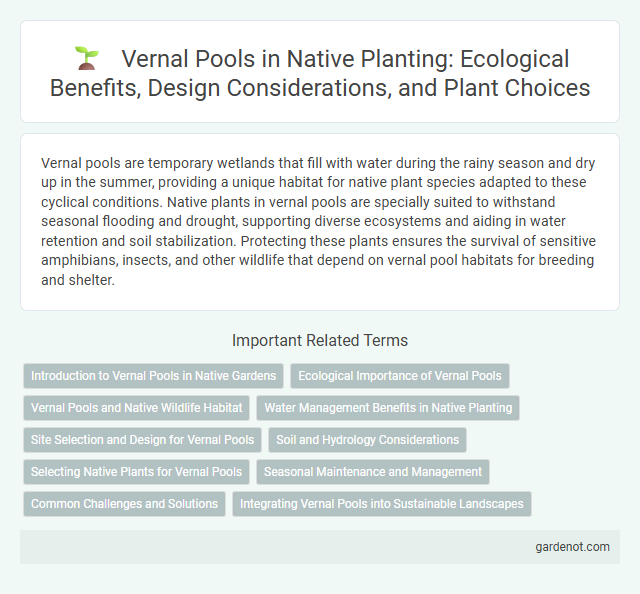Vernal pools are temporary wetlands that fill with water during the rainy season and dry up in the summer, providing a unique habitat for native plant species adapted to these cyclical conditions. Native plants in vernal pools are specially suited to withstand seasonal flooding and drought, supporting diverse ecosystems and aiding in water retention and soil stabilization. Protecting these plants ensures the survival of sensitive amphibians, insects, and other wildlife that depend on vernal pool habitats for breeding and shelter.
Introduction to Vernal Pools in Native Gardens
Vernal pools are temporary wetlands that form in shallow depressions during rainy seasons, providing critical habitats for native amphibians, insects, and specialized plants. These pools support unique biodiversity by filling with water in winter and drying out by summer, creating a dynamic environment that encourages native species adapted to fluctuating moisture levels. Integrating vernal pools into native gardens enhances ecological balance, promotes water conservation, and fosters habitat connectivity for wildlife.
Ecological Importance of Vernal Pools
Vernal pools provide critical breeding habitats for diverse amphibian species, including salamanders and frogs, that rely on these temporary wetlands for reproduction free from fish predation. These seasonal pools support unique plant communities adapted to fluctuating water levels, contributing to regional biodiversity and ecosystem resilience. Vernal pools also function as natural water filters, enhancing groundwater recharge and maintaining hydrological balance in native landscapes.
Vernal Pools and Native Wildlife Habitat
Vernal pools serve as critical seasonal wetlands that create unique habitats supporting diverse native wildlife, including amphibians like salamanders and frogs, as well as specialized invertebrates and migratory birds. These ephemeral pools rely on native plant species such as sedges, rushes, and wildflowers, which stabilize soil, filter water, and provide shelter and breeding grounds for wildlife. Protecting and restoring vernal pools with native vegetation enhances biodiversity, supports resilient ecosystems, and maintains essential natural processes within regional landscapes.
Water Management Benefits in Native Planting
Native plants in vernal pools naturally regulate water levels by absorbing excess runoff and slowly releasing moisture, which helps prevent flooding and erosion. Their deep root systems enhance soil infiltration and maintain water quality by filtering pollutants and sediments. This water management contributes to sustaining the unique hydrology and biodiversity characteristic of vernal pool ecosystems.
Site Selection and Design for Vernal Pools
Selecting a vernal pool site requires identifying seasonal wetlands with optimal hydrology, typically shallow depressions that collect rainwater in spring and dry by summer. Designing vernal pools involves preserving native vegetation buffers to support amphibian and invertebrate life while minimizing soil disturbance and runoff. Proper grading ensures natural hydroperiods, facilitating habitat diversity and supporting endemic species adapted to these ephemeral ecosystems.
Soil and Hydrology Considerations
Vernal pools require well-drained, compacted clay or silty soils that retain water long enough to support seasonal inundation, essential for amphibian breeding and specialized plant species. Hydrologically, these pools depend on a shallow water table and seasonal rainfall patterns to create temporary aquatic habitats without permanent outflows. Proper soil composition and hydrologic conditions ensure the preservation of these unique ecosystems within native planting projects.
Selecting Native Plants for Vernal Pools
Selecting native plants for vernal pools involves prioritizing species adapted to seasonal wet and dry cycles, such as Blue Flag Iris (Iris versicolor) and Marsh Marigold (Caltha palustris). These plants provide essential habitat and food sources for amphibians and invertebrates while stabilizing soil and filtering water. Incorporating native perennials and sedges like Carex spp. enhances ecosystem resilience and supports biodiversity in these ephemeral wetlands.
Seasonal Maintenance and Management
Seasonal maintenance of vernal pools involves monitoring water levels and removing invasive species to preserve native plant diversity critical for local amphibians and invertebrates. Management practices emphasize protecting the natural hydrology by preventing sedimentation and maintaining buffer zones of native vegetation. Regular assessment during wet and dry phases supports habitat stability and enhances ecological resilience.
Common Challenges and Solutions
Vernal pools face common challenges such as seasonal water fluctuations, invasive species, and habitat disruption from human activities. Maintaining hydrological integrity through careful land management prevents premature drying or flooding, which supports native plant germination and growth. Employing targeted invasive species control and promoting native vegetation buffer zones enhances the ecological resilience of vernal pools.
Integrating Vernal Pools into Sustainable Landscapes
Integrating vernal pools into sustainable landscapes enhances biodiversity by providing critical breeding habitats for amphibians and supporting native plant species adapted to seasonal wetlands. These ephemeral water bodies naturally filter stormwater, reducing runoff and improving water quality in surrounding ecosystems. Incorporating vernal pools into land management plans promotes ecological balance and resilience in urban and rural environments.
Vernal pool Infographic

 gardenot.com
gardenot.com